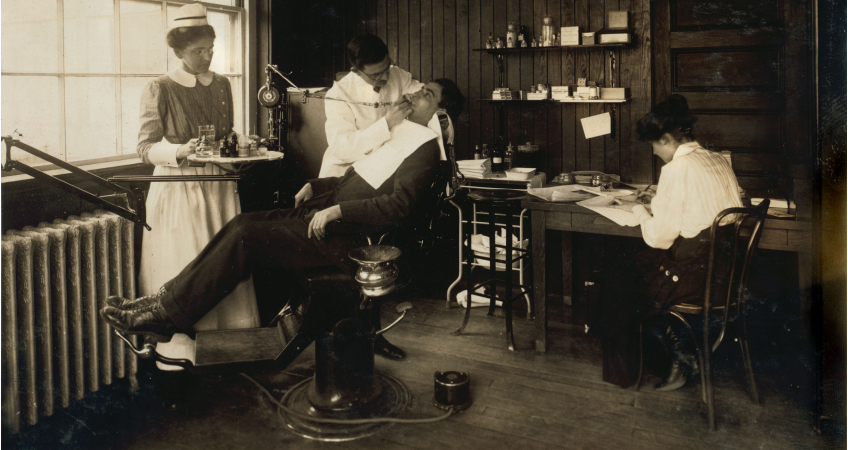The Introduction of the Rubber Dam in Operative Dentistry
A rubber dam is a simple yet essential tool in dentistry, often overlooked but immensely valuable in clinical practice. In a series of Spear Digest articles, we’ll explore its significance, origins, and practical benefits, and discuss why rubber dams matter, their historical development, and how they enhance dental procedures. From their humble beginnings to their everyday applications, we’ll provide insights and tips for efficient rubber dam placement.
The origin of the rubber dam
In 1896, a method for isolating teeth using a gold band wrapped around the tooth was described. This technique was known as a “cofferdam” (or a watertight enclosure), a term still used in continental Europe for rubber dams.
The rubber dam was first conceived by Dr. Sanford Christie Barnum of Monticello, New York.

On March 15, 1864, Dr. Barnum wrote:
“It was a result of my torment caused by saliva. I had passed hours, tired, and distracted by my incessant struggle against unending saliva contamination. I had passed many sleepless nights obsessed over my sad failure asking myself the same old question, which had yet to be answered, ‘How can I keep the cavity dry?’ The answer revealed itself while I was working on a lower left molar, in a mouth in which saliva was flowing everywhere. Desperate and eager to try a new idea, I made a hole in my protective napkin and placed it around a tooth and that is how the rubber dam came to be.”1
How the cofferdam went mainstream
A rubber dam was first used on patient Robert C. Benedict, a Monticello jeweler.
Its usage was first documented in the Dental Cosmos by Francis in 1865 and described as “Barnum’s Rubber Dam.” The paper also recommends using “waxed silk” to floss between the contacts and improve adaptation.
Barnum declined to patent his invention and, after advice from his uncle, Dr. Clowes, and a close friend, Dr. John Allen, presented it to the dental profession as his gift. This was noted by the American Dental Association at its August 1870 meeting in Nashville, Tennessee, with the resolution:
“That the thanks of the American Dental Association be and hereby are tendered to Dr. Sanford C Barnum for the invention, perfection, introduction, and donation of the Rubber Dam to the dental profession.”
This presentation was accompanied by the gifting of a gold watch and chain, marking a significant moment of recognition for Barnum. His contribution garnered worldwide acknowledgment and further citations from the California State Dental Association and the American Dental Society of Europe.
Continuing innovation based on Barnum’s legacy
In 1882, SS White, a dental manufacturing firm founded by the dentist Samuel Stockton White, developed the rubber dam hole punch, which remains in use today.
In June 1875, Delos Palmer, a dentist from New York, patented “Clamps for Rubber Dams” (U.S. Patent #164,870), which are now showcased at The National Museum of American History in Washington, D.C. These clamps and the associated forceps bear a striking resemblance to the instruments used in contemporary dentistry. Later, modifications for clamps were made by Bancroft, Tee, Evans, and Long, among many others.
In 1972, Dr. Hunter A. Brinker, a dentist from Oviedo, Florida, described a technique for rubber dam retraction of tissues before root planing. The modified clamps Dr. Brinker described are excellent for tissue retraction and will be discussed in a later article. His quote, “To see is to know,” aptly explains the necessity for rubber dam in operative dentistry.
The exploration of the rubber dam’s history and significance underscores its vital role in modern dentistry. From its inception to its practical applications, it’s clear that the rubber dam offers numerous benefits, including improved isolation, infection control, and patient comfort. In my next article, I’ll delve deeper into the advantages of rubber dam usage, shedding light on how this tool can enhance dental procedures.
References
- Brinker HA. (1972). Access — the key to success. The Journal of Prosthetic Dentistry, 28(4), 391–401.
- Thorpe BL. The profession’s benefactor, the originator of the rubber dam. The Dental Review, Vol. 17, 1903.
- Francis CE (1865). The rubber dam. Philadelphia:: SS White Dental Manufacturing Co.
SPEAR campus
Hands-On Learning in Spear Workshops
With enhanced safety and sterilization measures in place, the Spear Campus is now reopened for hands-on clinical CE workshops. As you consider a trip to Scottsdale, please visit our campus page for more details, including information on instructors, CE curricula and dates that will work for your schedule.

By: Jason Smithson
Date: June 11, 2024
Featured Digest articles
Insights and advice from Spear Faculty and industry experts


